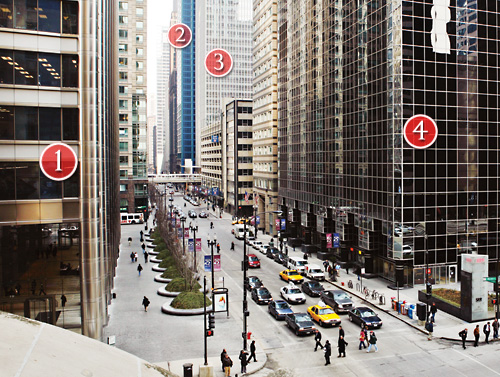From his fourth floor office in the Civic Opera House [20 N. Wacker Dr.], William Mason, general director of Chicago’s Lyric Opera, looks out on some of the most impressive buildings to join the city’s skyline in the past 30 years. The 1929 Civic Opera House has its own bragging rights-designed by the same team who brought us the Wrigley Building and the Field Museum, the 45-story limestone tower has two 22-story wings and is shaped like a throne on the west side, facing the Chicago River.
Mason says he loves the hustle and bustle of the area-“People walking on their lunch hours during the warm months and people staggering through the snow in the winter, as well as the pizza-by-the-slice truck that parks every day at the corner of Wacker and Madison, all the while listening to Verdi or Wagner, or whatever is rehearsing on our stage.”
[1] When completed in 2001, UBS Tower (1 N. Wacker Dr.) was the first large multi-tenant tower built in Chicago in a decade. Designed by James Goettsch of Lohan Associates, the 51-story, 1.75 million-square-foot structure is dramatic down to its street level, where clear glass walls surround three sides of the lobby.
[2] Although the tower at 10 S. LaSalle was completed in 1986, its bottom four floors belong to the 1915 Otis Building, whose upper portion was demol-ished to make way for the modern addition. The decorative stone base keeps the classical architecture of LaSalle Street, while the 33-story tower channels contemporary with blue aluminum and glass, and lime green piping.
[3] The city’s only tower completed by architect Cesar Pelli, 181 W. Madison is also the 16th tallest Chicago building. The 50-story art moderne structure has a recessed crown and is clad in white granite. The vaulted ceiling in the five-story lobby echoes an entrance of the Uffizi Gallery in Florence, and two Frank Stella sculptures flank the lobby’s end walls.
[4] Starchitect Helmut Jahn stirred a media frenzy in 1980 when he announced his plans for the 40-story postmodern office tower at One South Wacker Drive. The concrete structure sets back twice to create three floor areas, and its exterior walls of black, silver, and coral glass windows shape into a “draped curtain” at the building’s entrance.


